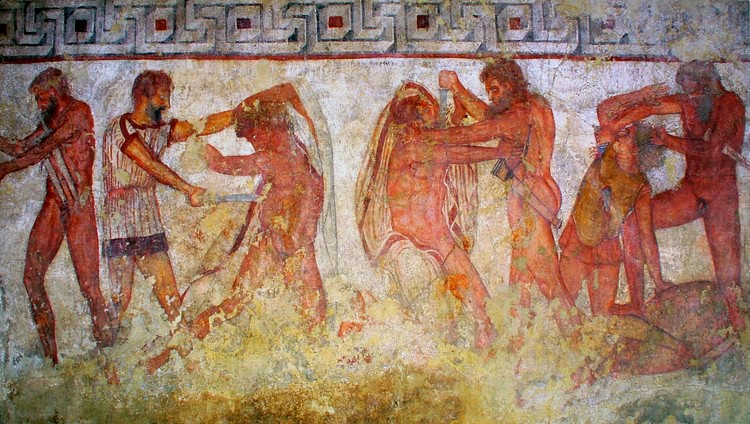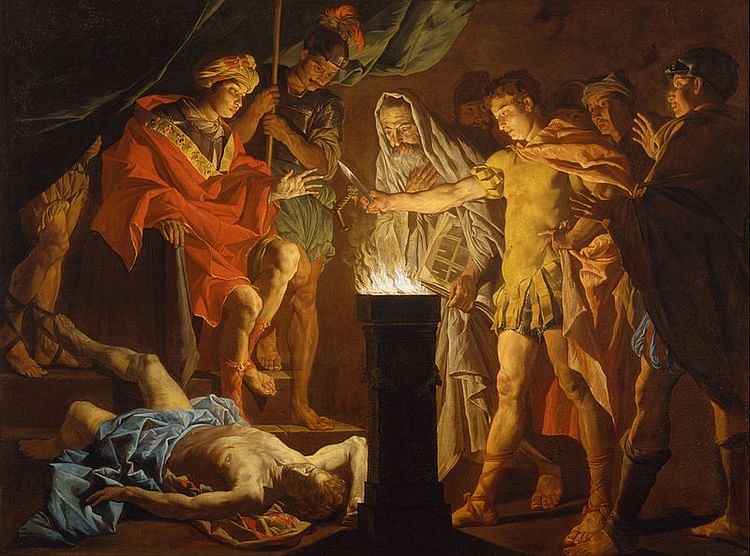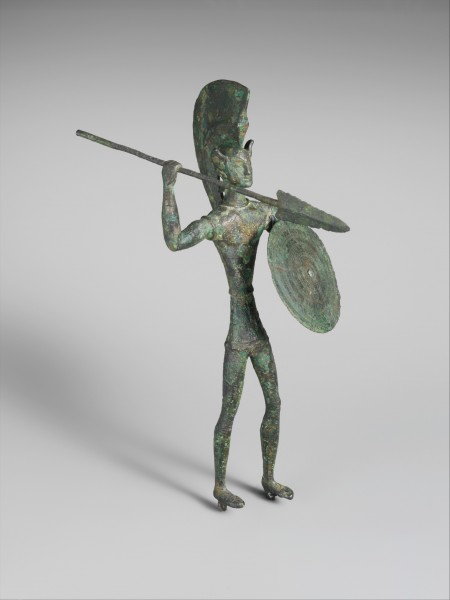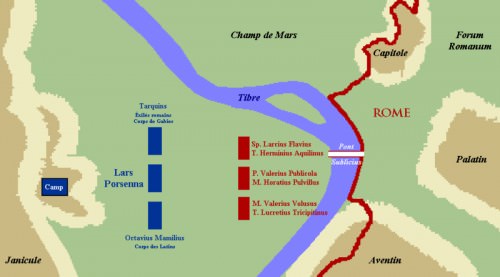Francois Tomb › Lars Porsenna » Ancient origins
Articles and Definitions › Contents
- Francois Tomb › Ancient History
- Lars Porsenna › Who Was
Ancient civilizations › Historical and archaeological sites
Francois Tomb › Ancient History
Definition and Origins

The Francois Tomb is an Etruscan tomb located at Vulci (Velch to the Etruscans ), a town located 12 km from the western coast of central Italy, by the banks of the Fiora River. Flourishing as a trading port between the 6th and 4th century BCE, Vulci's elite built many impressive tombs, and the most celebrated is the 4th-century BCE Francois Tomb. Vibrant wallpaintings on the interior walls depict scenes from mythology, a battle between Vulci and an alliance of other Etruscan citiesand the Romans in a tantalising glimpse of the still obscure relations between these two cultures, and, finally, the tomb's occupant himself.
DISCOVERY
The Francois Tomb was discovered in 1857 CE by Alessandro Francois who had been charged by Prince Torlonia, owner of vast swathes of Tuscany, to excavate the area around Vulci in search of valuable antiquities. Assisted by the historian A. Noel des Vergers, Francois would justify his reputation for lucky finds once again. He had already discovered near Chiusi the magnificent Attic black-figure vase named after him in the previous decade, and now Francois brought to light one of the most brilliantly painted and significant of all Etruscan tombs. The tomb was located in a cliff face of volcanic rock above the river Fiora, its entrance blocked by loose rubble. Dating to the mid-4th century BCE, the tomb consisted of a long passageway which led to a central atrium chamber with smaller chambers leading off it. The passageway alone took over two weeks of digging to traverse. Des Vergers describes the moment when they finally reached the tomb itself:
Everything was in the same state as on the day when the entrance was walled up. Ancient Etruria appeared before us as it was in the days of its glory. The warriors lying in full armour on their biers seemed to be resting from the battles they had fought against the Romans and Gauls. For a few minutes their shapes, clothes, stuffs, colours were visible. Then everything vanished as the outside air penetrated into the crypt, threatening to extinguish our flickering torches. It was an evocation of the past that was briefer than a dream and then faded away, as if to punish us for our reckless curiosity. (Keller, 141)
 FRANCOIS TOMB PLAN
FRANCOIS TOMB PLAN

WALL PAINTINGS
Mythological Scenes
The wall paintings of the Francois Tomb were removed by Torlonia and added to his private collection, but they are now preserved in the Villa Albani in Rome. The atrium had two main scenes, both of which are bloody massacres: an episode from Theban myth and another from Homer 's Iliad. The former shows Eteocles (King of Thebes and son of Oedipus ) and his brother Polyneikes, both nude, just at the moment of killing each other with their swords and blood consequently spurting everywhere.
The scene from the Iliad shows the sacrifice of Trojan prisoners during the funeral of Achilles ' favourite sidekick Patroclus.The Greeks are portrayed naked and killing their victims with swords. Also depicted are the figures of Charun, the gatekeeper to the underworld carrying his usual hammer (used to dislodge the heavy crossbar of the gate), and a winged Vanth, one of the Etruscan female divinities who acted as the messengers of death.

Battle Scene, Francois Tomb
An Etruscan Battle
Mixed with these mythological scenes another wall seems to be a representation of an actual battle between the Etruscans of Vulci and rivals from the other Etruscan towns of Volsinii and Sovana. To add another layer of complexity, several of the ten figures are named along with their town using the Etruscan alphabet. While some figures have Etruscan names, others have Roman ones, in reference perhaps to the 6th-century BCE conflict between the Etruscans and Romans which saw various dynastic power struggles where several of Rome's early kings were of Etruscan origin. This period of history remains obscure, and the tomb offers invaluable information, if not full answers, as to the early relations between the two cultures.
THE FRANCOIS TOMB OFFERS INVALUABLE INFORMATION, IF NOT FULL ANSWERS, AS TO THE EARLY RELATIONS BETWEEN THE ETRUSCANS & ROMANS.
The named individuals in the battle include three heroes of Vulci: Macstrna, who may be Rome's legendary second Etruscan king Servius Tullius by another name, and Caile and Avle Vipinas (two brothers) who probably were actual historical figures with tradition stating that they had settled in Rome on the Caelian Hill. Macstrna is in the act of freeing Caile Vipinas whose hands are tied, while Avle Vipinas and three others, presumably also from Vulci, attack with swords a coalition group from Volsinii, Sovana, and Rome. A Roman is identified as Cnaeus Tarquinius ( Cneve Tarchunies Rumach ), and he is cowering beneath the sword of Marce Camitlnas about to be killed. Some historians regard this Roman figure as Tarquinius Priscus, the legendary king of Rome (r. 616-579 BCE) or a younger relation. If it is the king, then the painting provides an alternative to the Roman tradition that Priscus was assassinated by his sons. The Francois Tomb would suggest that he actually lost his throne in battle with the Etruscans. This depiction of the conflict between the early Etruscan and Roman kings, created 200 years after the events, may have been due to an increasing threat of further hostilities between the two cultures at the time of the tomb's construction.

Vel Saties & Arnza, Francois Tomb
Vel Saties & the Bird
Another painting in the tomb, originally located by the doorway of the atrium, shows a man named in an inscription as Vel Saties, perhaps the occupant of the tomb. The figure, possibly a magistrate or auspicium (reader of omens), wears a dark blue embroidered cloak which has several nude male figures who are dancing while carrying shields. The man also wears a laurel crown and is accompanied by a dwarf who is named as Arnza. The dwarf is kneeling while holding a woodpecker or swallow attached to a string. The bird is about to be released, and Vel Saties looks on, perhaps, as in one interpretation, he is about to read the flight of the bird and divine its significance as an omen, a practice common in the Etruscan religion. Alternative interpretations suggest the bird is no more than a child's pet, and a third that Vel Saties gazes at the bird about to be released in a metaphor for his own imminent passage into the next life.
Lars Porsenna › Who Was
Definition and Origins

Lars Porsenna was the semi-legendary Etruscan king of Chiusi who famously attacked and probably occupied Rome c. 508 BCE when the city had just exiled its last king and was moving towards becoming a republic. His extravagant tomb is described by Pliny but has never been found.
Details of the early life of Lars Porsenna (also spelt Larth Porsina), his accession, and even the dates of his reign are all lacking. This is perhaps not surprising for a figure who is more legend than fact. He sprang into history only via the records of Greek and Roman historians writing centuries after his lifetime and who were only concerned with his infamous siege of Rome. More is known of his kingdom Chiusi, Etruscan name Clevsin and Clusium to the Romans, which was a powerful city in central Italy and a prominent member of the Etruscan League. The growth and prosperity of Chiusi in precisely the period of Porsenna's reign is attested by archaeological evidence.
LUCIUS TARQUINIUS SUPERBUS
Lucius Tarquinius Superbus (the 'Proud') was a member of the Etruscan Tarquinii clan from Tarquinia. He was Rome's seventh, and in the event, last king. Following his tyrannical reign and the rape of the Roman noblewoman Lucretia by Tarquinius' son Sextus and her subsequent suicide, the aristocrats of Rome, led by Lucius Iunius Brutus and Lucius Tarquinius Collatinus, persuaded the assembly to exile their king in 510 BCE. Brutus and Collatinus declared themselves Rome's first consuls, and the Roman Republic was born. However, Tarquinius was actually away laying siege to Ardea at the time of his exile vote and so was still both willing and able to make a serious attempt to retake his throne. Tarquinius first joined forces with the Etruscan cities of Cerveteri, Tarquinia, and Veii. A combined force attacked Rome but was defeated at the battle of Silva Arsia. Undeterred Tarquinius then convinced Lars Porsenna, to lay siege to Rome c. 508 BCE.
LARS PORSENNA WAS THE ETRUSCAN KING WHO ATTACKED AND CONQUERED ROME IN THE VERY FIRST YEAR THE CITY HAD BECOME A REPUBLIC AFTER A LINE OF SEVEN KINGS.
THE SIEGE OF ROME
The exact motivation for Porsenna's attack is unclear. Traditionally, this second attack was seen as an attempt to restore Rome's monarchy and Lucius Tarquinius to the throne, but following Porsenna's siege of the city he, instead, did one of two things. Version one has Porsenna finally withdrawing after being impressed with the city's fortitude and especially the heroism of figures such as Horatius Cocles (the 'one-eyed') and Gaius Mucius Scaevola.
Horatius Cocles had courageously held the wooden Sublician bridge, at that time the only access across the Tiber, against Porsenna's entire fighting force until it could be destroyed and the advancing army halted. Caught on the wrong side of the river the hero had had to swim back across to safety. Meanwhile, Mucius Scaevola was perhaps even more daring and stole into Porsenna's camp - the Etruscan king had by then set up his siege of the city - in an attempt to assassinate the king in his own tent. Unfortunately, Mucius did not know what Porsenna looked like and so mistakenly killed the king's secretary sitting next to his master. Captured, Mucius bravely displayed his resistance to torture by voluntarily putting his left hand into a fire (hence his name Scaevola, meaning left-handed).

Etruscan Bronze Warrior
Porsenna, seeing that such a heroic people would not be quashed, then gave command of half his army to his son Arus who moved off to attack the Latin town of Aricia. Then a third heroic figure Roman writers could not resist recording for posterity appears: Cloelia. She was one of a number of hostages Porsenna took to guarantee the safe withdrawal of troops from the city, but she escaped and swam across the Tiber. Impressed with her courage Porsenna set her free and half of the other Roman hostages he held, selected by Cloelia.
Version two of the siege, and much the more credible one, has Porsenna victorious and Rome surrendering to the Etruscan king, who then, far from reinstalling Tarquinius Superbus, acted to abolish the monarchy of Rome and imposed a harsh peace treaty which included complete disarmament and the handing over of all lands on the right bank of the Tiber. Porsenna then used the city as a military base to attack the Latin cities starting with Aricia in 504 BCE.
Naturally, this version was a little less palatable for the Roman reader than the heroic first version. It would also seem unlikely that Porsenna and Tarquinius could have been allies given their long-standing rivalry and the latter's alliance with Chiusi's traditional enemies the Latins and Cumae. Dionysius of Halicarnassus further states that the Tarquinii had dishonoured Roman ambassadors and hostages, and for this reason, there was a rupture between the ex-king and Porsenna. In the event, Arus would be defeated at Aricia - the city had support from Cumae - and was killed in the action. The remnants of Porsenna's army then made their way back to Rome.

Siege of Rome by Porsenna
Meanwhile, Rome's ex-king Tarquinius was forced to seek refuge with his son-in-law Octavius Mamilius, the dictator of the Latins (according to one version of the legend), who sought, rather improbably given the longtime rivalry between Rome and the Latin cities, to restore Tarquinius to the throne. Following Mamilius' defeat at the Battle of Lake Regillus (499 or 496 BCE) to the Romans - aided by the legendary appearance of the semi-divine figures of Castor and Pollux - Lucius Tarquinius moved on to Cumae in Campania where he died in 495 BCE.
PORSENNA'S TOMB
What happened to Porsenna after his withdrawal from Rome is not known besides that the peace between Chiusi and Rome was respected. His next and final appearance in literature is a detailed description of his tomb by the Roman writer Pliny who quotes word-for-word a text by Varro. Located outside the city walls of Chiusi, his description is as follows:
a square monument built of squared blocks of stone, each side being 300 feet long and 50 feet high. Inside this square pedestal there is a tangled labyrinth, which no one must enter without a ball of thread if he is to find his way out. On this square pedestal stand five pyramids, four at the corners and one at the centre, each of them being 75 feet broad at the base and 150 feet high. They taper in such a manner that on top of the whole group there rests a single bronze disk together with a conical cupola, from which hang bells fastened with chains; when these are set in motion by the wind, their sound carries to a great distance, as was formerly the case at Dodona. On this disk stand four more pyramids, each 100 feet high, and above these on a single platform, five more. ( Historia Naturalis 36.91-3, quoted in Simon, 207-8)
The description may be exaggerated, and no trace has ever been found of the tomb despite numerous attempts in the vicinity of Chiusi. Still, the fact that such a monument was deemed plausible by the Romans is testimony to the wealth and power of Etruscan Chiusi and its greatest ever king.
LICENSE:
Article based on information obtained from these sources:with permission from the Website Ancient History Encyclopedia
Content is available under License Creative Commons: Attribution-NonCommercial-ShareAlike 3.0 Unported. CC-BY-NC-SA License